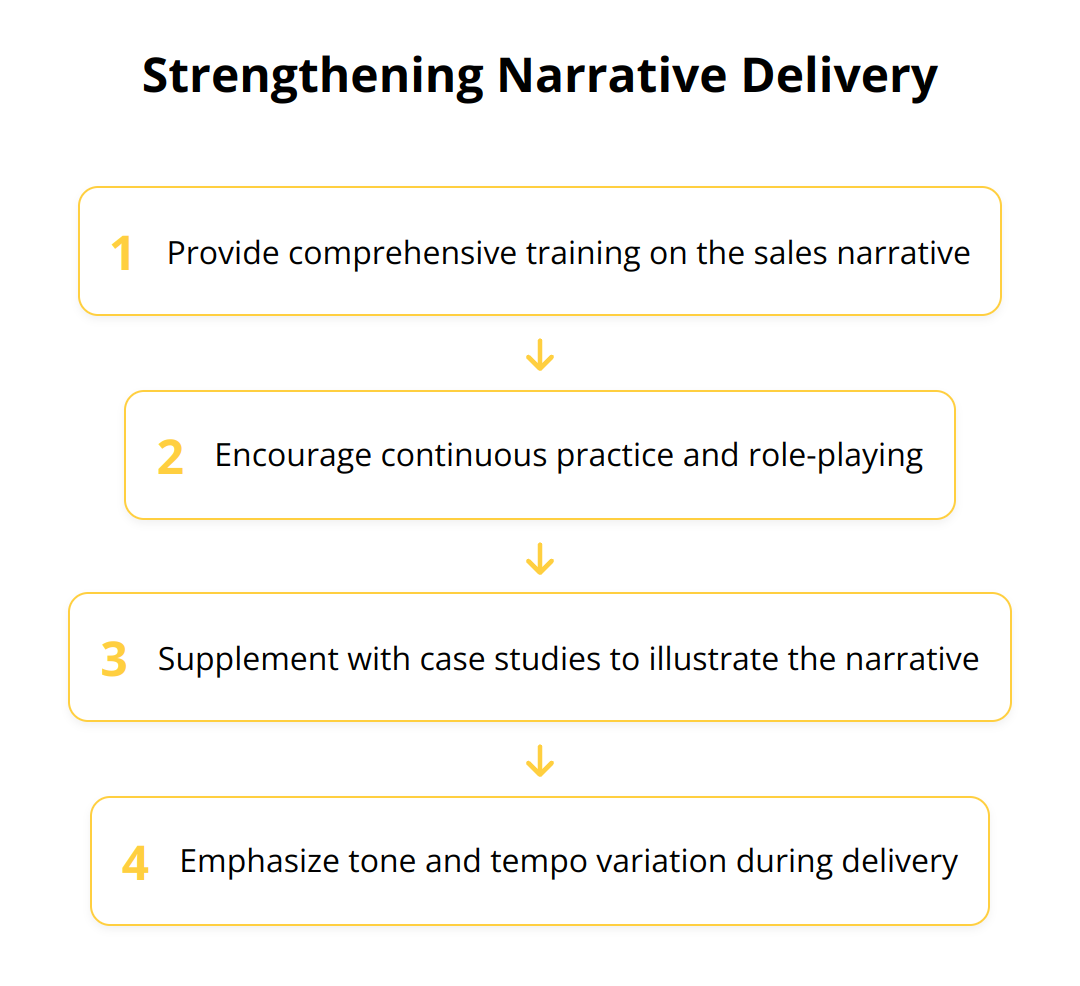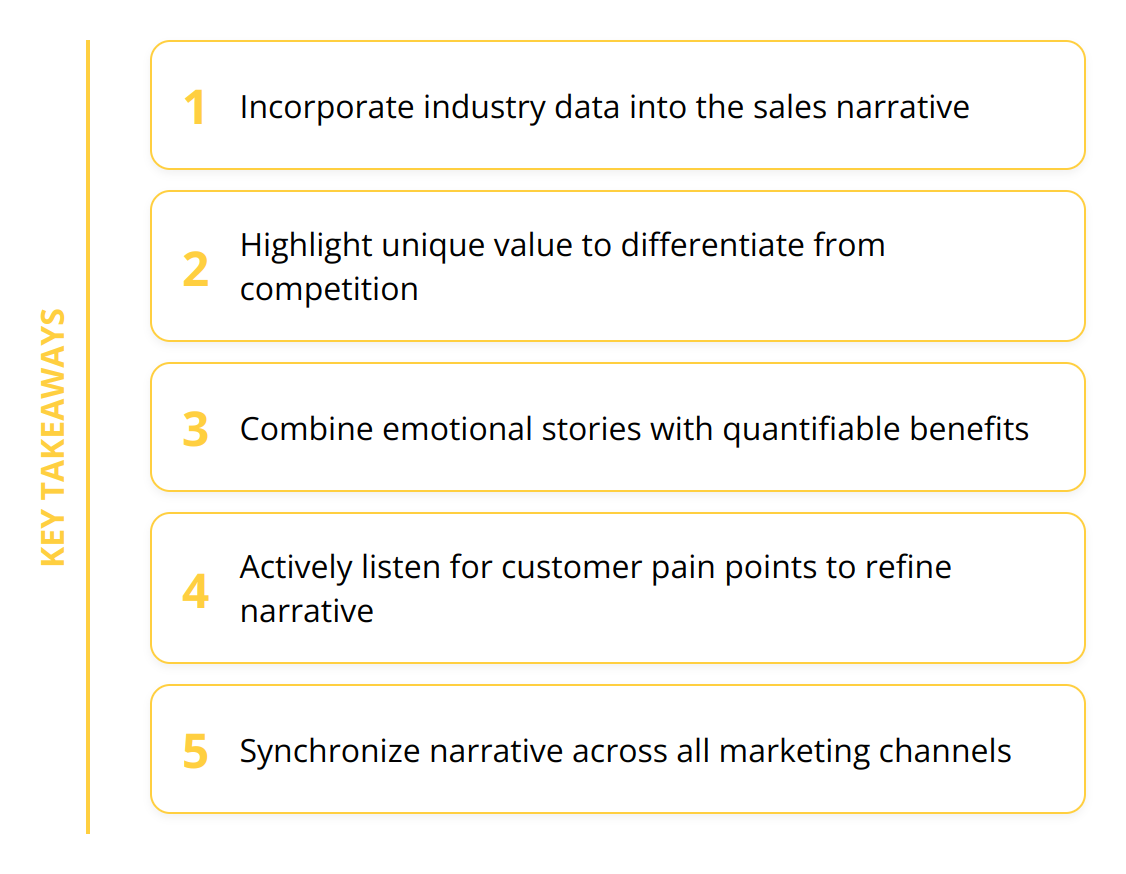Sales Narrative Development: What You Need to Know

We at Recherche Digital understand that a well-crafted sales narrative can significantly influence your business’s success. An effective sales story not only captivates but also convinces your customers that your product or service is the solution they’ve been seeking.
It’s not just about having a compelling tale to tell; it’s about weaving in the facts, figures, and emotions that resonate with your audience. In this post, we’ll guide you through the essentials of shaping and implementing a sales narrative that has a tangible impact on your results.
Crafting Your Sales Story
The core strength of your sales approach hinges on a robust narrative that does more than just share information—it compels the listener to act. A strategic narrative can elevate your sales conversations from mere transactions to meaningful exchanges that build lasting relationships with your customers.
The Power of Persuasion Through Narrative
A persuasive sales narrative creates a bridge between what you offer and what your customers truly need. Think about the last time a story moved you to take action—perhaps it was a case study that showcased a dramatic turnaround for a business much like yours, or it was a testimonial that struck a chord with your own experiences. These stories aren’t successful by chance; they’re meticulously designed to tap into the audience’s aspirations and challenges, creating an almost palpable need for the solution being presented.

Components of a Compelling Sales Narrative
An effective sales narrative has several key ingredients:
- Relevance: It must relate closely to the customer’s situation. Incorporate data that reflects their industry trends and speaks to their specific pain points.
- Clarity: Present a clear before-and-after picture. Use metrics from successful presentations to show tangible benefits.
- Emotion: People purchase on emotion and justify with logic. Weave in narratives that elicit emotions, aligning your product or service as the hero in the storyline.
- Differentiation: Highlight what sets your offering apart. Demonstrating unique value can be a deal clincher.

Aligning Storytelling with Sales Goals
Storytelling in the sales process is less about fiction and more about framing. It’s about constructing a narrative that aligns with your sales objectives, whether that’s to illustrate the uniqueness of a product, to humanize your brand, or to convey the transformative impact of your solution. Stories turn abstract concepts into concrete experiences and, in a practical sense, can help customers visualize their success as a consequence of partnering with you.
Let’s consider a practical example. The statistics show that adding a human element to your presentation can improve comprehension and retention rates. When pitching a new software tool, rather than focusing solely on features, a sales narrative might explore a day in the life of a current user, detailing time saved and the ease of completing tasks that once were cumbersome. Including specific improvements, such as a 30% reduction in time spent on routine tasks, makes your narrative not only relatable but also quantifiable.
Remember to regularly update your sales narrative to keep up with changing market trends and customer needs. Insist on feedback from your sales team after their pitches and incorporate what resonates with customers into future narratives.
This chapter is a stepping stone. It’s about taking the raw material of facts and figures and transforming them into a story that sells not just a product, but a vision. The next chapter will take these elements and show you how to weave them into a narrative that not only tells but sells.
Sharpen Your Sales Edge
When forming your sales narrative, precision matters. Positioning your product or service effectively is pivotal to convince customers why they should choose you over the competition. This is where understanding your Unique Selling Proposition (USP), grasping the client’s pain points, and skillfully combining data with emotional appeal come into play.
Firstly, pinpointing your USP requires more than an understanding of your product’s features. It requires a deep dive into what makes your solution not just different, but better. For instance, if your software guarantees industry-leading uptime, quantify this advantage by highlighting that clients experience 99.9% uptime, minimizing costly downtime compared to the industry average of 98%.

Knowing your customer’s pain points is equally crucial. Empathy is a powerful tool in sales. You must develop a keen insight into their daily challenges. Engaging directly with customers provides invaluable firsthand data. A survey from HubSpot revealed that 68% of customers are likely to share their pain points if asked. Use this knowledge to tailor your narrative, showing a direct link between their issues and your solutions.
The fusion of data and emotional appeal should not be underestimated. While numbers demonstrate value, stories trigger action. Our experience has shown that when a sales pitch includes customer success stories, it can increase close rates by up to 35%. Such stories should highlight statistical successes, like how your product boosted another client’s revenue by 25% within the first quarter.

Remember, a sales narrative is an art form that requires constant refinement. By ensuring it remains relevant, clear, and emotionally resonant, and by integrating hard data with human stories, your narrative will not simply be heard—it will be felt and remembered.
To elevate your narrative, consider these tips:
- Boldly state your USP early in conversations
- Actively listen to customers to identify new pain points
- Use data to support, not overshadow, your emotional appeals
Up next, learn how to use these foundational elements to give your sales narrative maximum impact in any customer engagement.
Implementing Your Sales Narrative
Implementing your sales narrative effectively requires careful orchestration across all facets of your organization. Every interaction with a client is an opportunity to reinforce your brand’s story and its distinctive qualities—making alignment and strategic implementation critical.
Sales Team Mastery
A powerful narrative is only as effective as the team conveying it. Strengthening your sales team’s narrative delivery skills demands comprehensive training coupled with continuous practice. The sales team must not only memorize the narrative but also embody it, adapting it seamlessly to suit each customer’s unique concerns and objections. An informed sales team, deeply familiar with the narrative, can draw upon a repository of information, statistics, and customer success anecdotes to deliver a tailored and convincing pitch.
Equip your team with detailed case studies that illustrate the narrative in action, such as how a particular client enhanced their operational capacity by 40% after incorporating your solution. Offer role-playing exercises to sharpen their storytelling abilities. Highlight the importance of varying tone and tempo to engage customers and maintain their interest throughout the sales conversation.

Uniformity Across Channels
Your sales narrative should be omnipresent, reflecting a consistent story regardless of the platform. This includes your website, social media, brochures, and any customer-facing collateral. Any disparity between these can create confusion and weaken the trust in your message.
Ensure that your marketing team aligns with the sales narrative so that content across different platforms echoes the same core message. For example, your social media posts should encapsulate the same USP and success metrics featured in sales pitches, such as a 50% increase in efficiency for existing users, providing a unified front that reinforces the message across channels.
Assessing and Evolving the Narrative
As markets evolve, so too should your sales narrative. Employing a feedback loop that incorporates customer reactions, win/loss analysis, and competitive insights will refine the narrative’s effectiveness. Quantitative metrics, such as an increase in conversion rate or average deal size, indicate the narrative’s traction, but qualitative feedback from customers provides context to those numbers.
For instance, if customers consistently respond well to a story about a user who saved 10 hours a week with your tool, make it a centerpiece of your narrative. Conversely, if parts of the story are regularly met with skepticism, it’s time to reassess and adjust. Perhaps your team is asserting that the product is easy to use but customers report a steep learning curve. This discrepancy needs to be addressed, either by adjusting the narrative or by improving product training materials.
In brief, a strategic approach to implementing your sales narrative ensures that your message resonates clearly and persuasively. Engage your sales team in immersive training, maintain consistency across all communication channels, and constantly gauge the narrative’s impact to perfect your approach over time.
Key Takeaways:
- Train sales teams thoroughly, including role-playing and case studies
- Ensure narrative consistency across all marketing materials
- Adjust the narrative based on customer feedback and competitive dynamics
Realize that every touchpoint is a storytelling opportunity—master it, and your audience will not only understand your value proposition but will believe in it.
Final Thoughts
As demonstrated throughout this blog post, a compelling sales narrative can be a game changer for any business looking to increase engagement and conversions. It is an indispensable tool that, when crafted and utilized effectively, can help forge a deep connection between a brand and its audience. We at Recherche Digital believe in the transformative power of a well-designed presentation and see it as an extension of your sales narrative. By entrusting us with your presentation needs, you can elevate your business with the assurance of a Golden Frame Presentation service that understands the nuance and impact of a great sales story.

We summarize a few key takeaways for refining your sales narrative development:
- Personalize the story to resonate with your audience’s needs and emotions
- Use data to substantiate your story and illustrate real-world impact
- Differentiate your offering by highlighting your unique value proposition
- Ensure your sales narrative is consistent across all customer touchpoints
- Adapt and evolve your narrative based on customer feedback and market changes
The journey of shaping your sales narrative is continuous. Markets evolve, customer perspectives shift, and your narrative should mirror these changes to stay effective. The power of storytelling in sales lies in its ability to not just inform, but to inspire and drive action. As you refine your narrative, remember that it should be a living, breathing aspect of your sales strategy that grows and improves alongside your business.
Continuous improvement is vital. Always assess the effectiveness of your narrative, seek out customer feedback, and make necessary adjustments. Fostering an environment that values and encourages regular refinement will ensure that your sales narrative remains potent and relevant.
In closing, remember that the strength of a persuasive sales narrative lies in its authenticity, relevance, and the emotional connection it forges with the audience. As you endeavor to weave these elements into your own sales story, consider partnering with a team that appreciates the importance of presentation in storytelling. At Recherche Digital, we pride ourselves on delivering professional results that not only capture the essence of your brand story but also leave a lasting impression on your audience.
In your endeavor to create and implement an impactful sales narrative, keep these takeaways in mind:
- Authenticity is compelling
- Relevance is key
- Emotional connections seal the deal
By integrating these elements into your sales narrative, you’ll be setting the stage for increased rapport, trust, and ultimately, a more successful sales process.

 +91-9540344454 / 9999344454
+91-9540344454 / 9999344454 